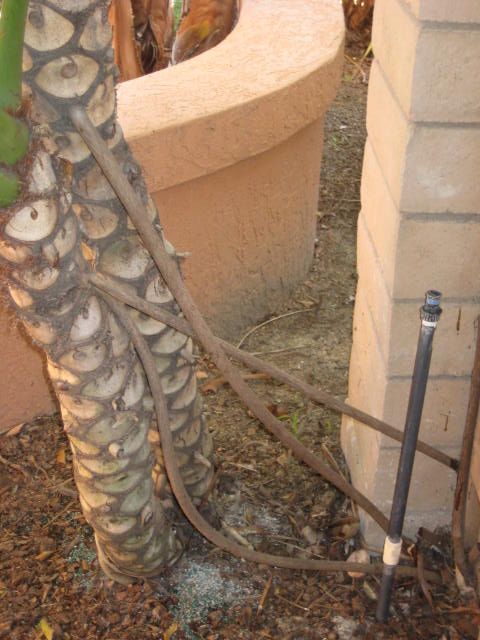Question 7 ft tree
7 ft tree
QUESTION: I had a 7 foot philodendron (I think, but see photo). I removed the tree, cutting its roots, because I'm redoing my landscape. I learned the tree had a long, extensive root system. I'm concerned about the roots continuing to grow as I think they might be under a tiled walkway and my house foundation. Am I okay or what should I do?
ANSWER: Looks like a palm not a philodendron. Palm type trees do not have an extensive root system.
Palms are often called trees, but they're only trees sometimes in height. They are monocots and are really related to giant grasses like bamboo, which are also monocots. This means, among many other things, that they have one seed leaf when their seeds germinate, as opposed to two seed leaves for dicots.
Another difference between monocots and dicots is that monocot structures do not so dramatically increase in size once the given plant is past the juvenile or seed leaf stage. In other words, a bamboo culm or palm tree stem (trunk) will stay much more nearly the same size it was when first formed than will a dicot stem. Monocot roots act the same way. Palm roots form from a 揵asal plate?at the base of the trunk and stay more or less the same diameter all along their length for the life of the palm. Chop a palm root, and it might sprout from where you cut it, or it might regrow.
IF the cut is fairly fresh with the week I would make another cut into the stump maybe across the stump and pour a herbicide called Roundup on the stump. The root system will absorb the herbicide and kill the root system. Roundup will ill any green plant it gets on so do not get the herbicide on any plant not wanting to be killed,
---------- FOLLOW-UP ----------
 Palm or philodendron?
Palm or philodendron?
QUESTION: The tree had long roots running from its trunk to the ground, in addition to the roots under the surface from the base of the trunk. I have attached a photo from a similar tree. Do you still think it a palm?
Also, the stump is completely removed. Since I understand the remaining roots can regrow, how may I kill them?
If I pour Roundup where the tree was located, would it kill any vegetation I may plant in the future?
ANSWER: The leaves do look like a palm. Since the tree is cut and the stump removed there is no need to apply the Roundup to the general area. About all that you can do is wait and see IF the roots will spout new foliage and them spray or wipe the foliage with the Roundup. The leaves will take the herbicide to the roots killing them. Wiping maybe better IF there are other green plant near by since if the roundup gets on any green plant the plant will die. Take a cloth and wet with the Roundup solution and wipe it on the leaves. I would wear plastic gloves since the herbicide does have an odor--the Roundup will not harm you if gotten on the skin but the odor may linger.
There is not a residual with Roundup so as soon as the liquid has dried plants can be plants in the area. This a herbicide that is used under shrubs to control weeds in plantings.
---------- FOLLOW-UP ----------
QUESTION: So, if I understand what you're writing, palm trees can have aerial roots?
AnswerThese are not aerial roots but roots called adventitious roots . Adventitious roots are the ones that form from shoot tissues, not from another (parent) root. Most commonly, adventitious roots arise out of stems, originating via cell divisions of the stem cortex or less often from axillary buds hidden in the bark. In some plants leaves can also be encouraged to form adventitious roots. The field of horticulture is based in large part on cloning plants from cuttings of stems or leaves that form adventitious roots. [examples: adventitious roots of a palm)
Adventitious roots arise out-of-sequence from the more usual root formation of branches of a primary root, and instead originate from the stem, branches, leaves, or old woody roots.
True Aerial roots: roots entirely above the ground, such as in ivy (Hedera) or in epiphytic orchids.
Her is a link to a picture of a palm with these roots. http://www.botgard.ucla.edu/html/botanytextbooks/generalbotany/typesofroots/a137







